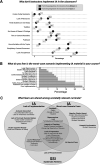Biology Instructors See Value in Discussing Controversial Topics but Fear Personal and Professional Consequences
- PMID: 37279089
- PMCID: PMC10424229
- DOI: 10.1187/cbe.22-06-0108
Biology Instructors See Value in Discussing Controversial Topics but Fear Personal and Professional Consequences
Abstract
Traditional biology curricula depict science as an objective field, overlooking the important influence that human values and biases have on what is studied and who can be a scientist. We can work to address this shortcoming by incorporating ideological awareness into the curriculum, which is an understanding of biases, stereotypes, and assumptions that shape contemporary and historical science. We surveyed a national sample of lower-level biology instructors to determine 1) why it is important for students to learn science, 2) the perceived educational value of ideological awareness in the classroom, and 3) hesitancies associated with ideological awareness implementation. We found that most instructors reported "understanding the world" as the main goal of science education. Despite the perceived value of ideological awareness, such as increasing student engagement and dispelling misconceptions, instructors were hesitant to implement ideological awareness modules due to potential personal and professional consequences.
Figures



References
-
- Aikenhead, G. (2002). Renegotiating the culture of school science: Scientific literacy for an informed public. In Millar, J. (Ed.), Imporving Science Education (pp. 245–264). United Kingdom: McGraw-Hill Education.
-
- American Association for the Advancement of Science. (2011). Vision and change in undergraduate biology education. Retrieved July 2, 2021, from https://visionandchange.org
-
- American Association of Community Colleges. (2021). Fast Facts. Retrieved July 2, 2021, from www.aacc.nche.edu/research-trends/fast-facts
-
- Andrews, T. C., Brickman, P., Dolan, E. L., Lemons, P. P. (2021). Every tool in the toolbox: Pursuing multilevel institutional change in the DeLTA Project. Change: The Magazine of Higher Learning, 53(2), 25–32.
Publication types
MeSH terms
LinkOut - more resources
Full Text Sources

